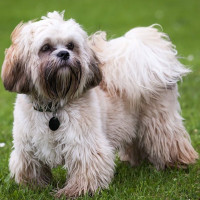Appearance of the Tibecot
|
| Tibecot hybrids are generally sturdy little dogs, slightly longer than they are tall. They may inherit the broad, flat feet with their unique round shape that give the Tibetan Terrier its sure-footedness on rocky surfaces, or the small, round feet characteristic of the Coton de Tuléar. The head is of moderate length and width, narrowing slightly towards the front to give it a slightly triangular shape, with a straight, medium-length muzzle, strong chin and tight, scissor bite. It has round, wide-set eyes, usually black or very dark brown, and V-shaped or triangular ears with heavy fur that hang over the sides of the head and frame the face. This cross can come in many different colors and markings due to the Tibetan Terrier heritage, but the addition of Coton de Tulear is likely to make all-white or predominantly white dogs more common. |
Temperament of the Tibecot
|
| Although this crossbreed is typically an easy-going, good-natured breed, it is also likely to be lively and intelligent, with expert problem-solving skills. They are extremely people- and pack-oriented, and can be prone to separation anxiety, untimely barking and destructive chewing if left alone for too long. While Tibecot hybrids are extroverted and affectionate with their family, they are more conservative and discriminating when it comes to humans outside their circle. Early and thorough socialization will enable your dog to maintain a polite attitude towards new people, and may also prevent the onset of fearful or anxious behavior. These small dogs tend to get on well with other dogs, although they can sometimes be a little bossy, but due to their hunting instinct, Tibecots may not be so secure with other animals. It's important to keep an eye on your Tibecot, as he's extremely intelligent and quite capable of climbing onto high counters, into closed cupboards and drawers, and sometimes even opening doors with his paws. If trained with gentle methods, this dog tends to learn tricks fairly quickly and retain them fairly well, but any tension or hostility on the part of the trainer can quickly derail a training session due to this dog's sensitivity. |
Needs and activities of the Tibecot
|
| Although this dog is lively and playful, it generally doesn't need much exercise to stay healthy and fit, and is usually content with around 30 minutes of vigorous activity a day. Exercise sessions are most effective if they are split into two or three shorter sessions throughout the day, and can include agility training, advanced obedience and sleight-of-hand training, puzzles and mental games designed for dogs, and perhaps even herding exercises in addition to more traditional walks and search games. If their tendency to bark is kept under control, these small, family-oriented dogs make excellent companions, whether in large or small spaces. |
Maintenance of the Tibecot
|
| This dog is likely to require more grooming time and effort than other dogs, and some Tibecot owners may choose to use the services of a professional groomer on a regular basis. These small dogs generally do better if bathed every month or two, and although the long coat has a fine or silky texture that sheds very little, it does tend to mat. This coat needs to be sprayed and brushed daily to remove knots before they become uncomfortable and difficult to remove, especially behind the ears, in the armpit area, on the belly and around the chest. Tibecots can also form tangles and mats between their toes, so it's especially important to pay special attention to their feet when grooming these little canines. |









 English (United Kingdom)
English (United Kingdom)